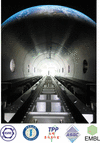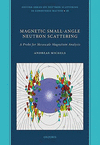issue contents
April 2022 issue

Cover illustration: An editorial in this issue of the journal highlights the Teaching and Education cateogory of Journal of Applied Crystallography [Dawe et al. (2022). J. Appl. Cryst. 55, 215–217]. Images courtesy of Juan Manuel García-Ruiz, with thanks to Maria Eugenia Mendoza, Martha Santana, and all the organizers of the Crystallization Contests in Spain and Mexico pictured here.
editorial
Free 

The development of the Teaching and Education (T&E) category of articles in Journal of Applied Crystallography, leading to the recent appointment of Louise Dawe as an additional T&E Editor, is described. Louise and ongoing T&E Editor Juan Manuel García-Ruiz outline their vision for the category.
research papers
An optimized methodology for collecting and analysing combined angular dispersive diffraction data is presented. This is particularly suitable for studying liquids or amorphous materials at high pressures.
This study shows that energy-resolved neutron imaging can be used to non-destructively characterize the microstructure of nickel-based superalloys, by providing maps of the spatial distribution of lattice parameters, misfit and misorientations of the γ and γ′ phases with a spatial resolution of ∼500 × 500 µm.
A temperature stability study has been performed during microwave plasma chemical vapor deposition (MPCVD) diamond growth.
The properties of highly oriented pyrolytic graphite used as optical components in neutron scattering instrumentation are reviewed. A careful X-ray characterization proves to be very helpful for the optimal configuration of composite crystal systems.
A mixing-flow reactor enables fast time-resolved X-ray scattering studies of solution-phase reactions under flow.
An in situ wide-angle X-ray scattering study is reported on the change of microcrystalline structure in Jincheng anthracite during high-temperature carbonization.
Open  access
access
 access
accessA description and the performance of the very small angle neutron scattering diffractometer at the National Institute of Standards and Technology are presented.
The stacking motif observed in complex alloys such as the μ-Al4Mn phase is investigated by molecular dynamics simulations.
A novel mechanism is presented to derive GSAS-II profile coefficients from a fundamental parameters description of an X-ray powder diffractometer. This can be used for standard-free determination of microstrain and crystallite size and has applications for machine learning.
Reciprocal space maps are numerically generated from molecular dynamics simulation data. This approach, referred to as computational diffraction, allows the determination of long-rage strains, distortions and disorder.
Open  access
access
 access
accessThe FUSION protein crystallization screen, which integrates 96 unique combinations of additives, is presented and its efficiency is demonstrated.
By studying the approaches to describing dynamical X-ray diffraction in a thick perfect crystal, it is shown that two-dimensional recurrence relations and the Takagi–Taupin equations are identical.
Open  access
access
 access
accessParticle shape functions are necessary to model powder scattering data that are in the form of intensity profiles and pair distribution functions. Here, an efficient method is presented to compute particle shape functions by orientational averaging of common volume functions. Contributions from particle size and size dispersity are accounted for via scaling and convolution.
Open  access
access
 access
accessA new endstation for biological small- and wide-angle X-ray scattering is detailed, which provides development opportunities for studying correlated local and global structures of biomolecules in solution.
Open  access
access
 access
accessNanodiamonds (NDs) produced by two different techniques have been studied by ultra-small- (USANS) and small-angle neutron scattering (SANS): (i) produced by the detonation of explosives in an oxygen-deficient atmosphere (TNT + hexogen), which results in the production of detonation nanodiamonds, and (ii) produced by laser ablation of a carbon–hydrocarbon mixture. The size distribution of the particles and the composition of the outer layers are expected to vary depending on the source of the NDs.
Open  access
access
 access
accessA Python-based analysis pipeline for the fast analysis of X-ray and neutron reflectivity data using neural networks is presented.
Open  access
access
 access
accessA one-step dehydration-based protein crystal cryoprotection protocol is presented. It is suitable for both low- and high-throughput projects, and may also benefit ligand occupancy and diffraction resolution. This same procedure can also be applied to discover new crystal hits from clear drops of already vapour diffusion equilibrated crystallization screening plates.
short communications
A large database of CIFs is used in conjunction with computational geometry software to calculate element-wise planar densities up to a maximum HKL index of 3.
computer programs
Open  access
access
 access
accessThis paper presents QUANTAS, an open-source Python-based software aimed at providing a fast, flexible and easy-to-use framework to calculate the thermodynamics and elastic properties of crystalline solids. QUANTAS could be of use for researchers involved in various fields of solid-state chemistry, physics and mineralogy.
ReciPro is a free and open-source graphical-user-interface-based crystallographic program that provides seamless access to functions to explore crystal databases, visualize crystal structures and goniometer settings, simulate diffraction patterns and high-resolution microscopy images, and analyse diffraction data.
New computational and graphical tools have been implemented in the EXPO software to improve the structure solution process from powder diffraction data with reciprocal- as well as direct-space methods.
Computer software for orbital-free quantum crystallography, which is based on multipole-model electron density, is described.
The program HRTex provides a new way of processing raw texture data from monochromatic neutron diffractometers.
letters to the editor
Comments are made on a paper by Toraya [J. Appl. Cryst. (2016), 49, 1508–1516] regarding two assumptions on the basis of which the intensity–composition formula was derived and the validity of the direct-derivation method in quantitative phase analysis.
The author responds to He and Li's comments on the paper by Toraya [J. Appl. Cryst. (2016), 49, 1508–1516].
book reviews
Free 



 journal menu
journal menu













































